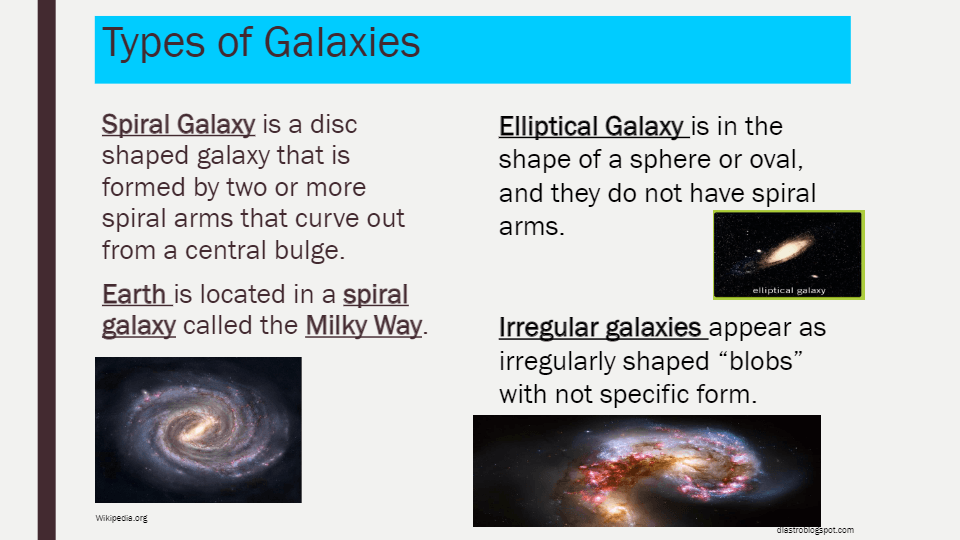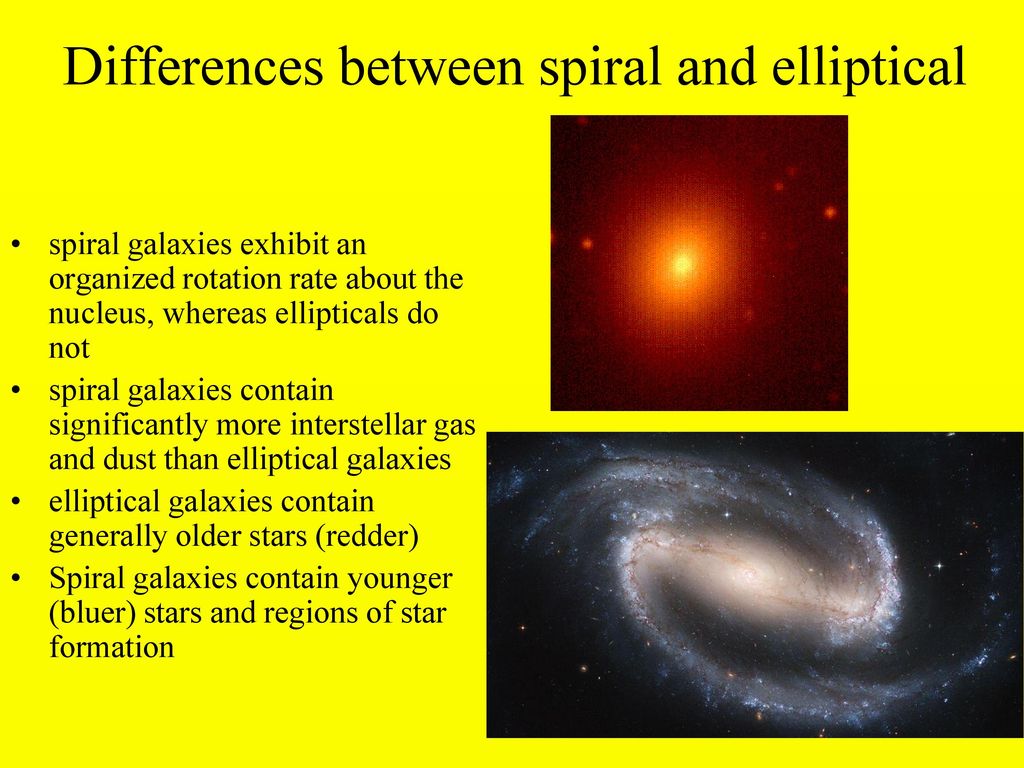Describe Elliptical Galaxies How Are They Different From Spiral Galaxies
Spiral galaxies elliptical galaxies and irregular galaxies. While the structure of both galaxies is largely similar this elongated bar suggests that the galaxy is a more mature version of the spiral galaxy.

Classification Of Galaxies Science Quizizz
While spiral galaxies are bright elliptical galaxies are dim.
. Tap again to see term. Spiral galaxies are spiral with arms that spin out from the center. Elliptical galaxies lack anything resembling the halo of a spiral galaxy elliptical galaxies are very old and spiral galaxies are very young elliptical galaxies have a spheroidal component of stars distributed spherically about the galactic center and spiral galaxies do not 1 See answer tnbuzz5569 is waiting for your help.
They can range in sizes smaller than the Milky Way to much larger. Spiral galaxies can be normal. Click again to see term.
Shaped as an ellipse or sphere. Elliptical galaxies are ellipses and spiral galaxies are spirals. Some can be shaped like a football.
Spiral galaxies are shaped almost like a circle and has arms spiraling out from the center. An example of a spiral shaped galaxy would be our own. The different types of galaxies not only appear different but have different evolutionary histories as well.
Tap card to see definition. The chart below summarizes the major differences between spiral galaxies and elliptical galaxies. Ellipticals were those galaxies in which all the interstellar matter was converted rapidly into stars.
They can contain a trillion stars or more and span as much as two million light. Elliptical Galaxies Elliptical galaxies are roughly egg-shaped ellipsoidal or ovoid found largely in galaxy clusters and smaller compact groups. The largest galaxies in the universe are giant elliptical galaxies.
Elliptical galaxies are shaped almost like an oval. Spiral galaxies spin so they appear as a rotating disk of stars and dust with a bulge in the middle like the Sombrero Galaxy shown in Figure belowSeveral arms spiral outward in the Pinwheel Galaxy seen in Figure below and are appropriately called spiral. An example of a spiral shaped galaxy would be our own galaxy the Milky Way.
The three fundamental classes of galaxies are elliptical spiral and irregular. Most of the galaxies we can easily observe are spirals about 45 25 or so are S0 about 25 are ellipticals of various kinds and a few are irregulars. Elliptical galaxies are shaped almost like an oval.
Spiral galaxies are hotbeds of star formation but elliptical galaxies arent nearly as. Also elliptical galaxies are round and three dimensional whereas spiral galaxies have relatively flat arms and a round center. Galaxies are divided into three types according to shape.
Spiral galaxies are shaped almost like a circle and has arms spiraling out from the center. Spiral and elliptical galaxies are very similiar and different. This idea turned out to be too simple as well.
The main difference between a barred spiral and unbarred spiral galaxy is the large bar that runs through the center of the former. Has a halo bulge and a disk. Spirals were galaxies in which star formation occurred slowly over the entire lifetime of the galaxy.
The difference is in shape. Spiral Galaxies Spiral galaxies are galaxies that have spiral arms that wind outward from the center. Spiral galaxies have lots of gas and dust which means it has younger stars.
An example would be galaxy ESO 325-G004. Difference- They differ in the shapes where some are elliptical some are spiral and some are even irregular. Subgroups of spirals are defined by the characteristics of their bulges spiral arms and how tightly wound those arms are.
Elliptical galaxies are shaped like 3D ellipses. They do not have any arms like you imagine in most galaxies like our own Milky Way. -elliptical galaxies formed from combination of top-down bottom-up -spiral galaxies formed from bottom-up Explain what we mean when we call the universe homogeneous and isotropic.
We shall explore the reasons for these differences in class. Identify the galaxy that you live in. The Sun and the rest of the solar system are located near the outer edge of the Milky Way Galaxy.
They do not have any arms like you imagine in most galaxies like our own Milky Way. Elliptical galaxies have littlr gas and dust which means it has older stars. The arms consist of bright stars dust and gas.
Bith are types of galaxies that have many objects held together by gravity. THE similarity and differences between the galaxies are- Similarity- All the galaxies in the universe contains stars asteroidsplanets and galactic cloud. An example would be galaxy ESO 325-G004.
How are they different from spiral galaxies. More older stars than newer. The Milky Way Galaxy shown in Figure 16 is a spiral galaxy.
Continue reading to learn about the similarities and differences. Galaxies are spiral elliptical and irregular.
Stars And Star Clusters Are Distributed Non Uniformly In Space They Are Grouped Into Giant Stellar Structures Known As Galaxies


Comments
Post a Comment